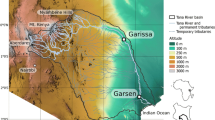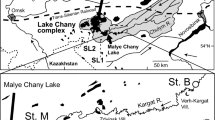Abstract
Tropical estuaries are increasingly altered by inputs from watersheds subject to widespread deforestation, as well as by globally driven hydrodynamic changes in adjoining seas. To assess contributions of C4 and C3 plants (from pasture and forest vegetation cover, respectively) to particulates exported from Pacific Panama watersheds, we measured δ13C and δ15N in suspended particulate matter (SPM) within eight mangrove estuaries whose watersheds differed in degree of conversion from forest to pasture land cover. These measurements also allowed evaluation of down-estuary transformations and the relative marine influence on transport and exchanges of particles between land, estuary, and sea. Imprint of watershed mosaic was detectable in δ13C of SPM within upper reaches of estuaries but disappeared down-estuary. Detectably heavier δ13C suggested that C4 plants contributed to SPM in upper reaches of estuaries. δ13C signatures were sufficiently sensitive to reveal presence of a small, but still detectable, contribution by C4 grasses to SPM. Influence of heavier marine-derived sources increased down-estuary, erasing terrestrial imprints. δ13C and δ15N in SPM, and in mangrove species present, became enriched down-estuary, likely from increased inputs of particulates bearing heavier signatures from upwelled waters. In this tropical Pacific region, estuarine particulates are subject to increasing shifts in land cover as deforestation increases, and to global-scale changes in hydrodynamic forcing of upwelled waters.






Similar content being viewed by others
References
Balesdent, J., and A. Mariotti. 1996. Measurement of soil organic matter turnover using 13C natural abundance. In Mass spectrometry of soils, ed. T.W. Boutton and S. Yamasaki, 83–11. New York: Marcel Dekker, Inc.
Barros, V.G., J. Mas-Plas, T.M. Oliviera Novais, E. Sacchi, and G.M. Zuppi. 2008. Hydrological mixing and geochemical processes characterization in an estuarine/mangrove system using environmental tracers in Babitonga Bay (Santa Catarina, Brazil). Continental Shelf Research 28 (4-5): 682–695.
Bender, M.M. 1968. Mass spectrometric studies of carbon 13 variations in corn and other grasses. Radiocarbon 10 (02): 468–472.
Bender, M.M. 1971. Variations in the 13C/12C ratios of plants in relation to the pathway of photosynthetic carbon dioxide fixation. Phytochemistry 10 (6): 1239–1244.
Bird, M.I., P. Giresse, and A.R. Chivas. 1994. Effects of forest and savanna vegetation on the carbon-isotope composition of sediments from the Sanaga River, Cameroon. Limnology and Oceanography 39 (8): 1845–1854.
Bouillon, S., R.M. Connolly, and S.Y. Lee. 2008. Organic matter exchange and cycling in mangrove ecosystems: Recent insights from stable isotope studies. Journal of Sea Research 59 (1-2): 44–58.
Cardelús, C.L., and M.C. Mack. 2010. The nutrient status of epiphytes and their host trees along an elevational gradient in Costa Rica. Plant Ecology 207 (1): 25–37.
Cernusak, L.A., K. Winter, J. Aranda, and B.L. Turner. 2008. Conifers, angiosperm trees, and lianas: Growth, whole-plant water and nitrogen use efficiency, and stable isotope composition (δ13C and δ18O) of seedlings grown in a tropical environment. Plant Physiology 148 (1): 642–659.
Cifuentes, L.A., R.B. Coffin, L. Solorzano, W. Cardenas, J. Espinoza, and R.R. Twilley. 1996. Isotopic and elemental variations of carbon and nitrogen in a mangrove estuary. Estuarine, Coastal and Shelf Science 43 (6): 781–800.
Collins, M., S.I. An, W. Cai, A. Ganachaud, E. Guilyardi, F.F. Jin, M. Jochum, M. Lengaigne, S. Power, A. Timmermann, G. Vecchi, and A. Wittenberg. 2010. The impact of global warming on the tropical Pacific Ocean and El Niño. Nature Geoscience 3 (6): 391–397.
D'Croz, L., and A. O'Dea. 2007. Variability in upwelling along the Pacific shelf of Panama and implications for the distribution of nutrients and chlorophyll. Estuarine, Coastal and Shelf Science 73 (1-2): 325–340.
Dewitte, B., J. Vasquez-Cuervo, S. Illig, K. Takahashi, G. Cambon, S. Purca, D. Correa, D. Gutierrez, S. Sifeddine, and L. Ortieb. 2012. Changes in El Niño flavours over 1958-2008: Implications for long-term trend of the upwelling off Peru. Deep-Sea Research II 77-80: 143–156.
Dittmar, T., R.J. Lara, and G. Kattner. 2001. River or mangrove? Tracing major organic matter sources in tropical Brazilian coastal waters. Marine Chemistry 73 (3-4): 253–271.
Domingues, T.F., L.A. Martinelli, and J.R. Ehleringer. 2007. Ecophysiological traits of plant functional groups in forest and pasture ecosystems from eastern Amazônia, Brazil. Plant Ecology 193 (1): 101–112.
von Fischer, J.C., and L.L. Tieszen. 1995. Carbon isotope characterization of vegetation and soil organic matter in subtropical forests in Luquillo, Puerto Rico. Biotropica 27 (2): 138–148.
Hedges, J.I., W.A. Clark, P.D. Quay, J.E. Richey, and A.H. Devol. 1986. Compositions and fluxes of particulate organic material in the Amazon River. Limnology and Oceanography 31 (4): 717–738.
Herbon, C.M., and I. Nordhaus. 2013. Experimental determination of stable carbon and nitrogen isotope fractionation between mangrove leaves and crabs. Marine Ecology Progress Series 490: 91–105.
Hirsch, A.I., W.S. Little, R.A. Houghton, N.A. Scott, and J.D. White. 2004. The net carbon flux due to deforestation and forest re-growth in the Brazilian Amazon: analysis using a process-based model. Global Change Biology 10 (5): 908–924.
Holtum, J.A.M., and K. Winter. 2005. Carbon isotope composition of canopy leaves in a tropical forest in Panama throughout a seasonal cycle. Trees 19 (5): 545–551.
Kristensen, E. 2008. Mangrove crabs as ecosystem engineers; with emphasis on sediment processes. Journal of Sea Research 59 (1-2): 30–43.
Kristensen, D.K., E. Kristensen, and P. Mangion. 2010. Food partitioning of leaf-eating mangrove crabs (Sesarminae): Experimental and stable isotope (C-13 and N-15) evidence. Estuarine, Coastal and Shelf Science 87 (4): 583–590.
Leffler, A.J., and B.J. Enquist. 2002. Carbon isotope composition of tree leaves from Guanacaste, Costa Rica: Comparison across tropical forests and tree life history. Journal of Tropical Ecology 18 (01): 151–159.
Mariotti, A., F. Gadel, P. Giresse, and Kinga-Mouzeo. 1991. Carbon isotope composition and geochemistry of particulate organic matter in the Congo River (Central Africa): Application to the study of Quaternary sediments off the mouth of the river. Chemical Geology 86 (4): 345–357.
Martinelli, L.A., S. Almeida, I.F. Brown, M.Z. Moreira, R.L. Victoria, L.S.L. Sternberg, C.A.C. Ferreira, and W.W. Thomas. 1998. Stable carbon isotope ratio of tree leaves, boles and fine litter in a tropical forest in Rondônia, Brazil. Oecologia 114 (2): 170–179.
Martinelli, L.A., M.V. Ballester, A.V. Krusche, R.L. Victoria, P.B. de Camargo, M. Bernandes, and J.P.H.B. Ometto. 1999a. Landcover changes and the δ13C composition of riverine particulate organic matter in the Piracicaba River Basin (southeast region of Brazil). Limnology and Oceanography 44 (7): 1826–1833.
Martinelli, L.A., M.C. Piccolo, A.R. Townsend, P.M. Vitousek, E. Cuevas, W. McDowell, G.P. Robertson, O.C. Santos, and K. Treseder. 1999b. Nitrogen stable isotopic composition of leaves and soil: Tropical versus temperate forests. Biogeochemistry 46 (1-3): 45–65.
Nardoto, G.B., J.P.H.B. Ometto, J.R. Ehleringer, N. Higuchi, M.M. da Cunha Bustamante, and L.A. Martinelli. 2008. Understanding the influences of spatial patterns on N availability within the Brazilian Amazon forest. Ecosystems 11 (8): 1234–1246.
Neill, C., L.A. Deegan, S.M. Thomas, and C.C. Cerri. 2001. Deforestation for pasture alters nitrogen and phosphorus in small Amazonian streams. Ecological Applications 11 (6): 1817.
O’Leary, M.H. 1988. Carbon isotopes in photosynthesis: Fractionation techniques may reveal new aspects of carbon dynamics in plants. Bioscience 38 (5): 328–336.
Ometto, J.P.H.B., L.B. Flanagan, L.A. Martinelli, M.Z. Moreira, N. Higuchi, and J.R. Ehleringer. 2002. Carbon isotope discrimination in forest and pasture ecosystems of the Amazon Basin, Brazil. Global Biogeochemical Cycles 16: 1109.
Ometto, J.P.H.B., J.R. Ehleringer, T.F. Domingues, J.A. Berry, F.Y. Ishida, E. Mazzi, N. Higuchi, L.B. Flanagan, G.B. Nardoto, and L.A. Martinelli. 2006. The stable carbon and nitrogen isotopic composition of vegetation in tropical forests of the Amazon Basin, Brazil. Biogeochemistry 79 (1-2): 251–274.
Parnell, A.C., R. Inger, S. Bearhop, and A.L. Jackson. 2010. Source partitioning using stable isotopes: Coping with too much variation. PLoS One 5: 5.
Parnell, A.C., D.L. Phillips, S. Bearhop, B.X. Semmens, E.J. Ward, J.W. Moore, A.L. Jackson, J. Grey, D.J. Kelly, and R. Inger. 2013. Bayesian stable isotope mixing models. Environmetrics 24: 387–399.
Pennington, J.T., K.L. Mahoney, V.S. Kuwahara, D.D. Kolber, R. Calienes, and F.P. Chavez. 2006. Primary production in the eastern tropical Pacific: A review. Progress in Oceanography 69 (2-4): 285–317.
Powers, J.S., and E. Veldkamp. 2005. Regional variation in soil carbon and δ13C in forests and pastures of northeastern Costa Rica. Biogeochemistry 72 (3): 315–336.
Roa Fuentes, L.L., P.H. Templer, and J. Campo. 2015. Effects of precipitation regime and soil nitrogen on leaf traits in seasonally dry tropical forests of the Yucatan Peninsula, Mexico. Oecologia 179 (2): 585–597.
Scanlon, B.R., I. Jolly, M. Sophocleous, and L. Zhang. 2007. Global impacts of conversions from natural to agricultural ecosystems on water resources: Quantity versus quality. Water Resources Research 43: W03437. https://doi.org/10.1029/2006WR005486.
Smith, B.N., and S. Epstein. 1971. Two categories of 13C/12C ratios for higher plants. Plant Physiology 47 (3): 380–384.
Terwilliger, V.J. 1997. Changes in the δ13C values of trees during a tropical rainy season: Some effects in addition to diffusion and carboxylation by Rubisco? American Journal of Botany 84: 1693–1700.
Valiela, I., L. Camilli, T. Stone, A. Giblin, J. Crusius, S. Fox, C. Barth-Jensen, R. Oliveira Monteiro, J. Tucker, P. Martinetto, and C. Harris. 2012. Increased rainfall remarkably freshens estuarine and coastal waters on the Pacific coast of Panama: Magnitude and likely effects on upwelling and nutrient supply. Global and Planetary Change 92-93: 130–137.
Valiela, I., C. Barth-Jenson, T. Stone, J. Crusius, S. Fox, and M. Bartholomew. 2013a. Deforestation of watersheds of Panama: Nutrient retention and export to streams. Biogeochemistry 115 (1-3): 299–315.
Valiela, I., A. Giblin, C. Barth-Jensen, C. Harris, T. Stone, S. Fox, and J. Crusius. 2013b. Nutrient gradients in Panamanian estuaries: Effects of watershed deforestation, rainfall, upwelling, and within-estuary transformations. Marine Ecology Progress Series 482: 1–15.
Valiela, I., M. Bartholomew, A. Giblin, J. Tucker, C. Harris, P. Martinetto, M. Otter, L. Camilli, and T. Stone. 2014. Watershed deforestation and down-estuary transformations alter sources, transport, and export of suspended particles in Panamanian mangrove estuaries. Ecosystems 17 (1): 96–111.
Valiela, I., E. Elmstrom, J. Lloret, T. Stone, and L. Camilli. 2018. Tropical land-sea couplings: Role of watershed deforestation, mangrove estuary processing, and marine inputs on N fluxes in coastal Pacific Panama. Science of The Total Environment 630: 126–140.
Viana, I., I. Valiela, P. Martinetto, R. Monteiro Pierce, and S.E. Fox. 2015. Isotopic studies in Pacific Panama mangrove estuaries reveal lack of effect of watershed deforestation on food webs. Marine Environmental Research 103: 95–102.
Voss, M., J.W. Dippner, and J.P. Montoya. 2001. Nitrogen isotope patterns in the oxygen-deficient waters of the Eastern Tropical North Pacific Ocean. Deep Sea Research Part I: Oceanographic Research Papers 48 (8): 1905–1921.
Wassenaer, T., P. Gerber, P.H. Verburg M. Rosales, M. Ibrahim, and H. Steinfeld. 2007. Projecting land use changes in the Neotropics: The geography of pasture expansion into forest. Global Environmental Change 17 (1): 86–104.
Acknowledgements
This work was funded by NSG Grant BIO-0842413; we thank Henry L. Gholz and Timothy K. Kratz of NSF for their support of this work. We would not have been able to carry out the fieldwork without the excellent resources of the Liquid Jungle Laboratory (LJL) built and operated by Jean Pigozzi and the Canales de Tierra Foundation, and we are much indebted to the LJL staff for providing excellent support and facilities to this work. We thank L. Madin, L. Camilli, and the Ocean Life Institute at the Woods Hole Oceanographic Institution for initial support and throughout the work. The support of the Woods Hole Consortium was instrumental to facilitating work by our multi-institutional research team. S. Wilkins, S. Baldwin, R. M. Oliveira, J. Tucker, R. McHorney, S. Kelsey, J. Brennan, K. Hernández, N. Mueller, and J. Bissonette helped carry out the demanding field work involved in the project.
Author information
Authors and Affiliations
Corresponding author
Additional information
Communicated by Marianne Holmer
Electronic supplementary material
ESM 1
(DOCX 22 kb)
Rights and permissions
About this article
Cite this article
Elmstrom, E., Valiela, I. & Fox, S.E. Watershed-Estuary Coupling in Pacific Panama: Isotopic Evidence of Forest and Pasture Land Covers on Watersheds and Marine Contributions to Suspended Particulate Matter in Mangrove Estuaries. Estuaries and Coasts 41, 1968–1976 (2018). https://doi.org/10.1007/s12237-018-0400-0
Received:
Revised:
Accepted:
Published:
Issue Date:
DOI: https://doi.org/10.1007/s12237-018-0400-0




